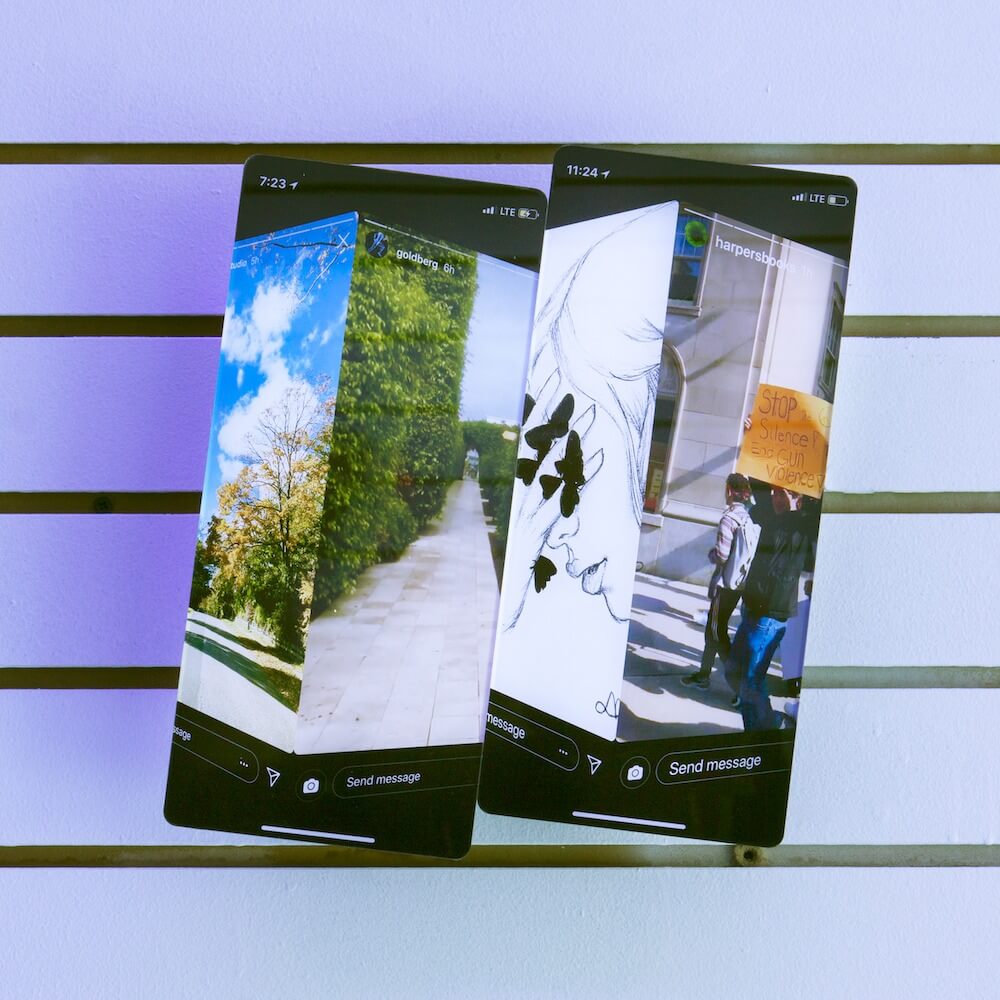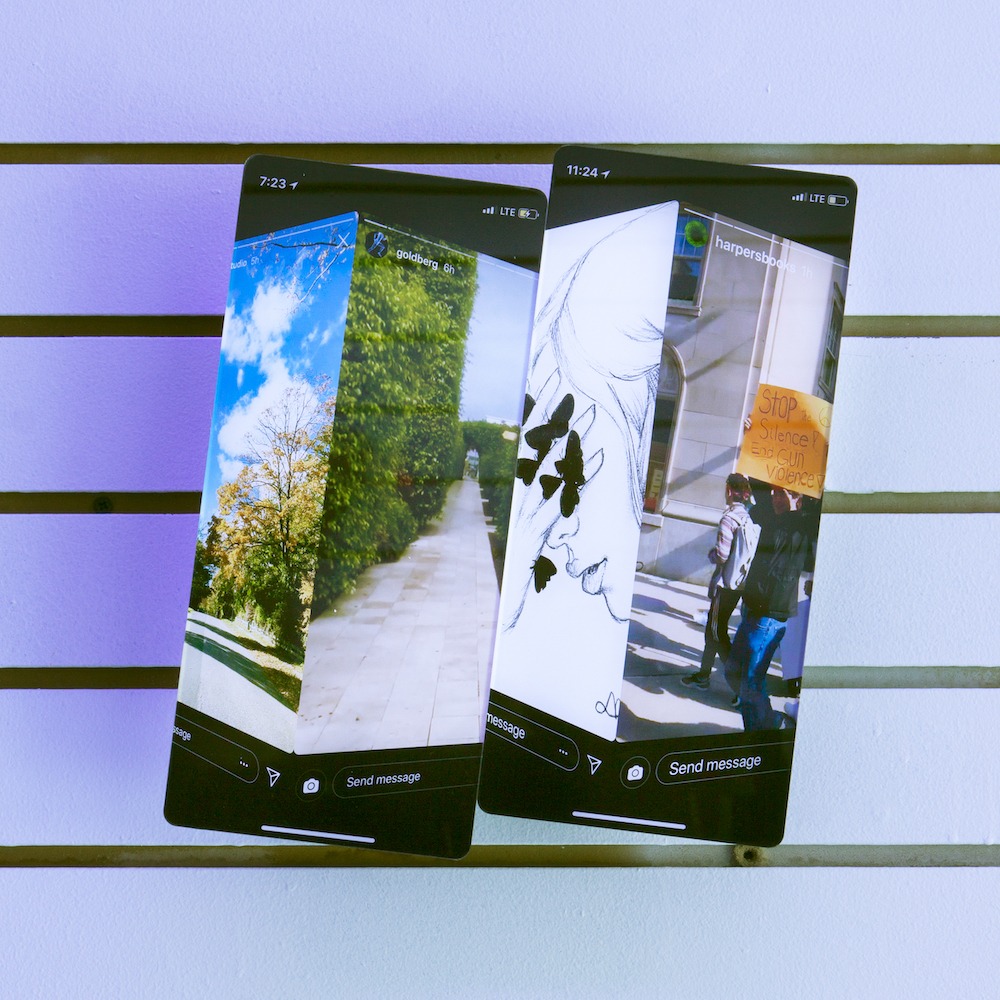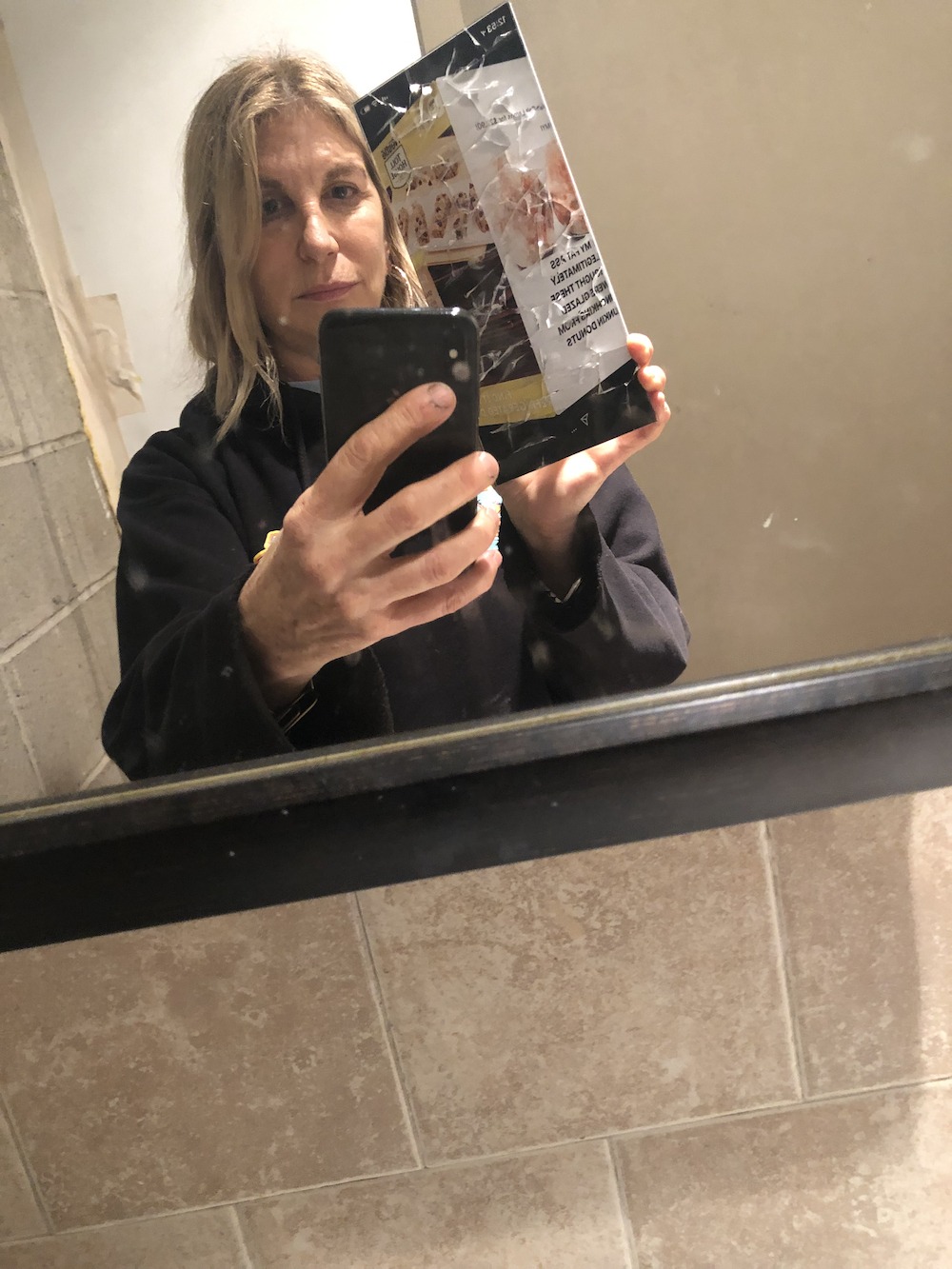Self-Fulfilling Loop: Jo Shane’s DISCLAIMER

Jo Shane’s work investigates themes of desire, consumption and human nature through a viscerally personal lens. This April, we caught her new installation DISCLAIMER in a transformed garage at Wallplay ON CANAL. DISCLAIMER is a conceptual installation that explores algorithms’ increasing role in our everyday lives. The garage displayed the vernacular of the preexisting merchandise culture of Canal Street; selling 48 inkjet photographs that depict a screenshot as found when spinning quickly between Instagram stories. Within an order prescribed by the platform’s proprietary algorithm, Shane extracted adjacent posts from her personal feed that struck her as visually or contextually compelling. Now placed in dialogue, the pairings elicit new threads of meaning and moreover, reveal our ultimate powerlessness over our own story within this liminal digital space. DISCLAIMER refers to the lack of responsibility Shane took for displaying unhindered images from the public domain, which she asserts are property of the algorithm once posted.
“In the 80’s I would always say I don’t want to go out, I wish we could have it on TV and just watch it. And now we have that moment.”

DISCLAIMER (2018-19)
Inkjet photo face-mounted to plexiglass on plexiglass, customized car phone mount, and optional security
5″ x 11″
Photo credits: @dafstudio, @goldberg, @brandon_lunch, @harpersbooks
What are your thoughts on how we consume images on Instagram, and how it has shifted our perception of self, performance and presentation?
Disclaimer was hatched with another project BE HERE NOW, my first public sculpture prototype, based on social media and selfies. I initially experienced an intense reaction to the proliferation of people taking photographs of themselves in front of art at Miami Basel in 2015. My distaste peaked at Doug Aitken’s Mirage, a 2017 Desert X project. The site-specific installation was a house of mirrors that became catnip to art selfie-mongerers and had to be shut down early because the crowds disrupted the surrounding neighborhood. Over time, I teased out the reactive nuances I experienced when viewing this phenomena. My initial pejorative response was one of ‘them and us’ – we (as artists) have intentions when creating work that have no relationship to the ‘I was here’ cultural trophy response by the public.

Virtual render of public sculpture prototype, concrete, monitors, tires, and inkjet printer
2018
I kept asking myself what specifically I found so distasteful. Was it the unconscious denigration of the work and the artist’s intention? Was it the fact that I or anyone I know would ever do this ( I guess all bets are off in relation to Yayoi Kusama’s infinite mirrors). Instead of taking my customary insider point of view, I considered, “What is it that makes people want to be part of this? What kind of validation is being pursued and does taking one’s photograph in front of a work for bragging rights on social media constitute an act of consumption as opposed to an experiential or visceral response?” I started thinking about the phenomena in terms of a human impulse that draws people to be in the presence of creative work. I also thought about the service that was historically provided to ‘elevate’ one’s scope of the world, to escape the mundane. Yet, this very act constitutes the proliferation of the mundane.
On a deeper level, the work isn’t complete until the viewer literally becomes a part of it. Create a work incorporating a selfie feed that is accessed on social media and beamed back to the participant in live time. ‘Be Here Now’ ,( the title of a 60’s time on meditation and mind expansion ), as opposed to ‘I Was There’. Turn the tables so to speak.

Self-portrait
Courtesy of the artist
In DISCLAIMER, what is relationship between private/public in how you source images?
It’s a limited cross-section, privately sourced and publicly aired. I wasn’t scientific, although I intended to present this as a cross-section of my purview. I’m not trying to do any deep excavating or seeking relative objectivity which would be an entirely different project. It’s subjective because it’s my feed and reflects my commentary. My work always reveals different subtexts when I am able to spend time with it outside of the studio. DISCLAIMER has revealed a more personal side (private and public, simultaneously) than I originally considered. Now I’m wondering if this is actually the latter-day Miss Lonely Hearts? Is this actually a portrait of the voyeur at home projecting themselves as part of these people’s lives that they aren’t in, yet having this (fantasy) sense of belonging? This trope could be my story or someone else’s story. Obviously, we are not all players and ‘influencers’. Most actors play themselves to varying degrees and most artists are creating subliminal self-portraits. I received feedback that made me realize the algorithm is actually producing a reflexive loop between me and the people I follow.
The more people I added, the more resolute the repetition became – a self-fulfilling loop of interest. I barely look at individual accounts anymore. I just march down the storyline as it presents itself. I don’t care who sees that I see their story. I have no shame. The project also gave me license to have no shame. But I don’t think I had it in the first place. I just don’t care if you know that I looked at your story. There’s no selectivity – it’s just a horizontal scroll born out of habit, boredom and voyeurism.

What is your take on voyeurism, stalking, trolling, insta-peeping?
Isn’t it natural human desire if the information is there to view it? Instagram is one big brew of voyeurism from start to finish. A dysfunctional but omnipresent way to calibrate who we think we are and how we see ourselves in relation to the world.
There are the obvious downsides. Nothing is real, people who follow influencers feel less-than. Women are so targeted for that. The other women they are viewing are never realistically represented. Presentation has always been altered. So there is that thing of people feeling bad and comparing themselves. It’s problematic. It can feed on itself, if you’re in a mood to look at things that will make yourself feel worse. Any mood you have you can amplify through social media. Negative moods, especially. Then there’s the good side where you see – “That’s where it’s going on? I’m leaving, I’m going, Byyye.” I just troll the Internet, troll Instagram and then just show up. So that’s a plus side in a way, too.
Youth culture is an ongoing thread in my work. I see myself think that I’m modelling my inner teenager, because I have some kind of attachment to not growing up. It’s like a high school yearbook. I’ve always been this person who’s exploring social networks. I love being on the tip of what’s happening, I love that energy. This project has a commentary in its physicality as well – is it the new iPhone pad?! “Is it an ad? An editorial? Is there a narrative?” It’s in between all of these states. It’s liminal on every level. Hopefully it creates an opportunity for discussion and most importantly, humor. What’s interesting to me is being present in the installation, watching people pass by, peek in and keep going as if to say, “Oh, I know this already.” Right now, I feel like it’s too well produced, too close to the real thing, and people don’t quite get it. We were asked if we sold chargers on the first day. It’s about consumption, production, desire. The algorithm creating your portrait with whom or what you supposedly desire based on previous choices invites product consumption, while also prompting you to produce content in order to insert yourself in the lineup.

DISCLAIMER(2018-19)
Inkjet photo face-mounted to plexiglass on plexiglass, customized car phone mount, and optional security
5″ x 11″
Photo credits: @phliphashley @cchris.ohh @fabiola.alondra unknown@chanelbeauty unknown@xariax
You have these objects and cultural artefacts in sculptures and installations, that seem as though you are performing and activating through your assemblage.
It’s my inner art shaman performing and bestowing (haha). Honestly, having these things around allows me to work extemporaneously which one could posit is a performative act. I think that we all like to believe that we are saying something bigger than the prosaic day-to-day by interfacing sources. That’s somewhat problematic, however, because the art world is historically hungry to invalidate people – women especially – and experientially based personal narratives are probably one of the easiest entry points on the invalidation map. I guess I’ll just keep making people uncomfortable or dismissive – that’s my job.
@joshane1, @joshanestudio, @___disclaimer___
Jo has a solo show at Kendra Jayne Patrick Gallery through June 1st, 2019.








